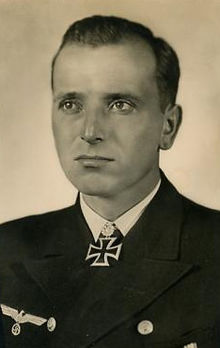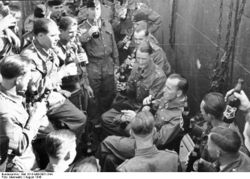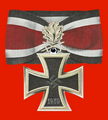Otto Kretschmer
| Otto Kretschmer | |
|---|---|
| 1 May 1912 – 5 August 1998 (aged 86) | |
 |
|
| Nickname | Otto der Schweigsame (Silent Otto) |
| Place of birth | Heidau, Liegnitz |
| Place of death | Bavaria |
| Allegiance | |
| Service/branch | |
| Years of service | 1930–1947, 1955–1970 |
| Rank | Reichsmarine (1930-1935): Leutnant zur See Kriegsmarine (1935-1945): Fregattenkapitan Bundesmarine (1955-1970): Flottillenadmiral |
| Unit | 2. Unterseebootsflottille 1. Unterseebootsflottille 7. Unterseebootsflottille |
| Commands held | U-35, 1937-07-31 – 1937-08-15 U-23, 1937-10-01 – 1940-04-01 U-99, 1940-04-18 – 1941-03-17 |
| Awards | Iron Cross 1st Class U-boat War Badge Knights Cross with Oak Leaves and Swords |
Flotilla Admiral Otto Kretschmer (1 May 1912 – 5 August 1998) was a German U-boat commander of the Second World War, and was the most successful Ace of the Deep. From September 1939 until being captured in March 1941, he sank 47 ships for a total of 274,333 tons. For this he received the Knights Cross with Oak Leaves and Swords, among other commendations. He earned the nickname "Silent Otto" both for his successful use of the "silent running" capability of the U-boats as well as for his reluctance to make radio broadcasts during patrols.
Contents |
Biography
Prewar career
Otto Kretschmer was born in Heidau, Liegnitz. At the age of seventeen he spent eight months living in Exeter, where he learned to speak English fluently. He joined the Reichsmarine in April 1930, and attained the rank of Seekadett after completing officer training courses as well as three months' aboard the training ship Niobe. Later he spent about a year serving about the light cruiser Emden and in December 1934 was transferred to a posting aboard the light cruiser Köln. Kretschmer remained aboard the Köln until he was transferred to the U-Boat force in January 1936, where he received extensive officer training and was promoted to Oberleutnant zur See.
Kretschmer's first command was the U-35, a Type VIIA U-Boat, in 1937. This promotion coincided with Germany's involvement in the Spanish Civil War, and U-35 was ordered to patrol the Spanish coast. U-35 returned to Germany after an uneventful patrol during which no ships were sunk. In September 1937, Kretschmer left the U-35 and took command of U-23, a Type IIB coastal U-Boat.
World War II
The German invasion of Poland found Kretschmer still in command of U-23, and he was soon sent into action along with the rest of the Kriegsmarine's U-Boat fleet. His first war patrols ranged across the North Sea and around the British coast. Kretschmer's first success came in Moray Firth where he attacked and sunk the Danish 10,517 ton tanker Danmark on January 12, 1940 using torpedoes. The British admiralty at that time thought that the tanker had struck a mine as they did not locate any U-boat in the area. A month later on 18 February, Kretschmer sank the 1,300 ton British fleet destroyer HMS Daring off the Pentland Firth while she was escorting convoy HN-12 from Norway. U-Boat crews almost always avoided deliberately engaging enemy destroyers, so the Daring's destruction was rightly seen as a very skillful attack by both Kretschmer and the U-23.
In April 1940, after eight patrols, Kretschmer left the U-23 and was transferred to the newly-completed Type VII B U-99, and in a sense started his legacy. After two months' training and shakedown maneuvers in German waters, U-99 went into action in June 1940. During the first four patrols of the U-99, Kretschmer started attacking convoys at night on the surface, taking down merchant ships with highly accurate shots, using only one torpedo per target ship in order to save ammunition, and the quote "One torpedo ... one ship" is attributed to Kretschmer from around this time. Kretschmer's tactics were widely copied throughout the U-Boat force, although they achieved mixed results in practice.
His most successful patrol occurred in November-December 1940. During that patrol, Kretschmer and U-99 sank three British armed merchant cruisers, HMS Laurentic (18,724 tons), HMS Patroclus (11,314 tons) and HMS Forfar (16,402 tons). Laurentic and Patroclus were sunk on the night of 3–4 November after they responded to distress calls from the 5,376 ton British freighter Casanare, which U-99 had mortally wounded about 250 miles west of Ireland. Forfar was sunk a month later on 2 December while steaming to join up with and escort outbound convoy OB-251. Put together, the three AMCs totalled over 46,000 gross tons. These three successes earned Kretschmer the number-one spot on the Aces list, and was never surpassed. Klaus Bargsten served aboard U-99 under Kretschmer, before being promoted to captain himself and becoming the sole survivor of U-521 on 2 June 1942. Siegfried von Forstner was another of Kretschmer's student officers aboard U-99 who later received the Knight's Cross of the Iron Cross as commanding officer of U-402.[1]
Kretschmer was also meticulous in his conduct towards the crews of torpedoed ships. When attacking lone merchant ships in the days before wolfpack tactics began in earnest, he had been known to hand down bottles of spirits and blankets into lifeboats and give them the course to the nearest land. On one patrol in September 1940, Kretschmer had also retrieved a survivor of another torpedo attack who was alone in the Atlantic on a small raft and took him aboard, transferring him later to a lifeboat after his next successful attack.[2]
On his last patrol in March 1941, he sank 10 more ships, but these were to be Kretschmer's last victims. On 17 March 1941, during a counterattack by British escorts of Convoy HX-112, U-99 was disabled after repeated depth charge attacks by the British destroyers HMS Walker and HMS Vanoc. Kretschmer surfaced and, under fire from the British vessels, scuttled his boat. Three of his men were lost, but Kretschmer and the remainder of U-99's crew were captured by the British. The same day saw the British escorts scored another success against the Kriegsmarine: another noted U-Boat skipper, Joachim Schepke, was killed aboard U-100 when that boat was rammed and sunk in heavy fog by Vanoc.
Kretschmer's usual standards of conduct were evident during the sinking of his boat; he signaled HMS Walker asking for rescue for his men, took pains to ensure as many left the submarine as possible, and assisted some of his crew towards the rescue nets hung from the British destroyer. Kretschmer's strength was evidently failing in the cold water and his own rescue was at the hands of a British sailor who climbed down the nets and plucked him from the water.[3]
A prisoner of war and postwar career

Upon his capture, he spent almost seven years as a P.O.W. in the hands of the British. In 1943 German command tried to rescue him (Operation Kiebitz) but that daring plan failed. In December 1947 he was allowed to return to Germany. Four of those years he spent in Canada at Bowmanville POW camp. Like several other surviving German naval veterans, Kretschmer joined the post-WWII German Navy, the Bundesmarine. He joined the newly-formed service in 1955 and two years later was appointed commanding officer of the 1. Geleitgeschwader (1st Escort Squadron). The next year he was transferred to the position of commander of the Bundesmarine's Amphibische Streitkräfte (Amphibious Forces). From 1962 onward he served as a staff officer in NATO before becoming Chief of Staff of the NATO command COMNAVBALTAP at Kiel in May 1965. He retired in September 1970 as a flotilla admiral.
In later years Kretschmer was often interviewed for television and radio programmes about the Second World War, and appeared in the 1974 documentary series The World at War. In the mid-1990s he was interviewed for the computer simulation game Aces of the Deep, as one of several U-boat skippers whose interviews were excerpted specially for the CD-Rom version of the game.
During a vacation in Bavaria during the summer of 1998, he died in an accident on a boat on the Danube, while celebrating his 50th wedding anniversary. He was cremated and his ashes were scattered at sea.
Achievements
Even though Kretschmer only served for one and a half of the six years of World War II, he would never be surpassed in terms of tonnage sunk. He was awarded the Iron Cross 2nd Class, the U-boat War Badge, the Iron Cross 1st Class, the Knight's Cross of the Iron Cross, the Knight's Cross with Oak Leaves, and the Knights Cross with Oak Leaves and Swords. He was mentioned five times in the Wehrmachtbericht (3 August 1940, 19 October 1940, 4 November 1940, 17 December 1940 and 25 April 1941).
U-23's career in the Black Sea
After Kretschmer left U-23 to assume command of U-99, U-23 participated in an unusual move by the Kriegsmarine. U-23, along with five other boats, was transferred over land and by river to the Romanian port of Constanza, from where they attacked Russian ships steaming in the Black Sea. This group, called the 30th Flotilla, sank many ships for the loss of three submarines, over two years. In August 1944, however, when Romania left the Axis powers, 30th Flotilla was stranded with no way to return to Germany. The submarines were scuttled. Recently, S. Kolay, a Turkish marine engineer, found the resting place of the three scuttled submarines and visited the wreck of one of them, U-20.[4]
Awards
- Dienstauszeichnung 4th Class (2 October 1936)[5]
- Medaille zur Erinnerung an die Heimkehr des Memellandes (26 October 1939)[5]
- Iron Cross (1939)
- U-boat War Badge (1939) (9 November 1939)[5]
- Knight's Cross of the Iron Cross with Oak Leaves and Swords
- Mentioned five times in the Wehrmachtbericht
References
- Citations
- ↑ Waters, John M. Jr., CAPT USCG (December 1966). Stay Tough. United States Naval Institute Proceedings. p. 99.
- ↑ Padfield, Peter; War Beneath the Sea: Submarine Conflict 1939-1945; John Murray, London, 1995
- ↑ Ibid
- ↑ Telegraph On-line edition, February 4, 2008
- ↑ 5.0 5.1 5.2 5.3 5.4 Busch and Röll 2003, p. 42.
- ↑ 6.0 6.1 6.2 Scherzer 2007, p. 474.
- Bibliography
- Berger, Florian (2000). Mit Eichenlaub und Schwertern. Die höchstdekorierten Soldaten des Zweiten Weltkrieges (in German). Selbstverlag Florian Berger. ISBN 3-9501307-0-5.
- Busch, Rainer & Röll, Hans-Joachim (2003). Der U-Boot-Krieg 1939-1945 - Die Ritterkreuzträger der U-Boot-Waffe von September 1939 bis Mai 1945 (in German). Hamburg, Berlin, Bonn Germany: Verlag E.S. Mittler & Sohn. ISBN 3-8132-0515-0.
- Fellgiebel, Walther-Peer (2000). Die Träger des Ritterkreuzes des Eisernen Kreuzes 1939-1945. Friedburg, Germany: Podzun-Pallas. ISBN 3-7909-0284-5.
- Kurowski, Franz (1995). Knight's Cross Holders of the U-Boat Service. Schiffer Publishing Ltd. ISBN 0-88740-748-X.
- Range, Clemens (1974). Die Ritterkreuzträger der Kriegsmarine. Stuttgart, Germany: Motorbuch Verlag. ISBN 3-87943-355-0.
- Robertson, Terence. The Golden Horseshoe: The Wartime Career of Otto Kretschmer, U-Boat Ace. London: Greenhill Books/Lionel Leventhaal Ltd.
- Scherzer, Veit (2007). Die Ritterkreuzträger 1939 - 1945 Die Inhaber des Ritterkreuzes des Eisernen Kreuzes 1939 von Heer, Luftwaffe, Kriegsmarine, Waffen-SS, Volkssturm sowie mit Deutschland verbündeter Streitkräfte nach den Unterlagen des Bundesarchives (in German). Jena, Germany: Scherzers Miltaer-Verlag. ISBN 978-3-938845-17-2.
- Williamson, Gordon and Bujeiro, Ramiro (2004). Knight's Cross and Oak Leaves Recipients 1939-40. Osprey Publishing Ltd. ISBN 1-84176-641-0.
- Die Wehrmachtberichte 1939-1945 Band 1, 1. September 1939 bis 31. Dezember 1941 (in German). München: Deutscher Taschenbuch Verlag GmbH & Co. KG, 1985. ISBN 3-423-05944-3.
- External link
- Otto Kretschmer in the German National Library catalogue (German)
- On line interviews (Realaudio)
- "Uboat.net". The Men – Otto Kretschmer. http://uboat.net/men/kretschmer.htm. Retrieved 25 February 2007.
- Telegraph On-line edition, February 4, 2008
|
|||||||||||
|
|||||||||||
|
||||||||

